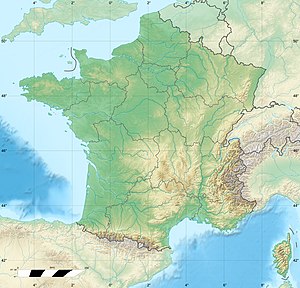| Battle of Brienne | |||||||
|---|---|---|---|---|---|---|---|
| Part of the Campaign of France of the Sixth Coalition | |||||||
 Napoleon was nearly taken by the Cossacks after the battle, but was saved by French general Gaspard Gourgaud. | |||||||
| |||||||
| Belligerents | |||||||
|
| |||||||
| Commanders and leaders | |||||||
| Strength | |||||||
| 36,000[1] | 28,000–30,000[1] | ||||||
| Casualties and losses | |||||||
| 3,000[1]–4,000 killed, wounded, or captured | ||||||
Location within France | |||||||
The Battle of Brienne (29 January 1814) saw an Imperial French army led by Emperor Napoleon attack Prussian and Russian forces commanded by Prussian Field Marshal Gebhard Leberecht von Blücher. After heavy fighting that went on into the night, the French seized a château, nearly capturing Blücher. However, the French were unable to dislodge the Russians from the town of Brienne-le-Château. Napoleon himself, making his first appearance on a battlefield in 1814, was also nearly captured. Very early the next morning, Blücher's troops quietly abandoned the town and retreated to the south, conceding the field to the French.
In late December 1813, two Allied armies initially numbering 300,000 men smashed through France's weak defenses and moved west. By late January, Napoleon personally took the field to lead his armies. The French emperor hoped to cripple Blücher's army before it could combine with the main Allied army under Austrian field marshal Karl Philipp, Prince of Schwarzenberg. Napoleon's gamble failed, and Blücher escaped to join Schwarzenberg. Three days later, the two Allied armies combined their 120,000 men and attacked Napoleon in the Battle of La Rothière.

